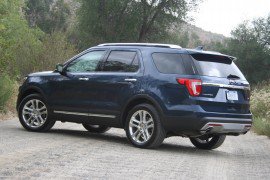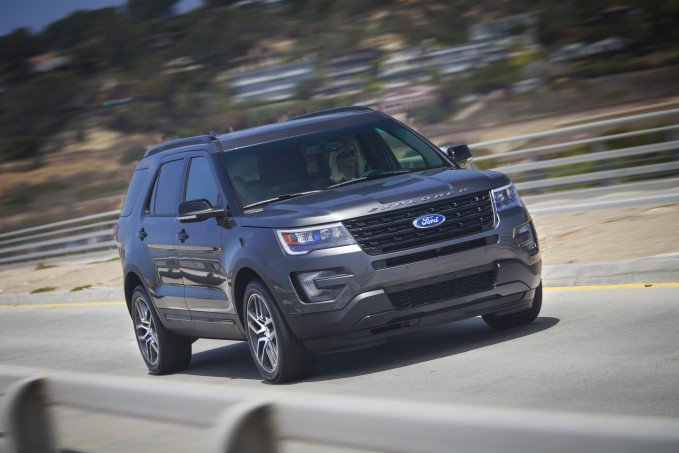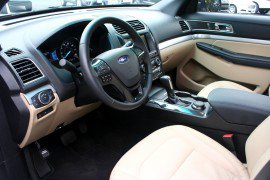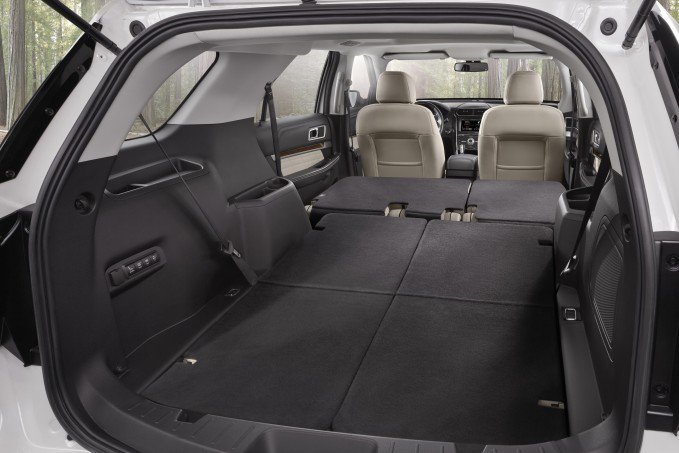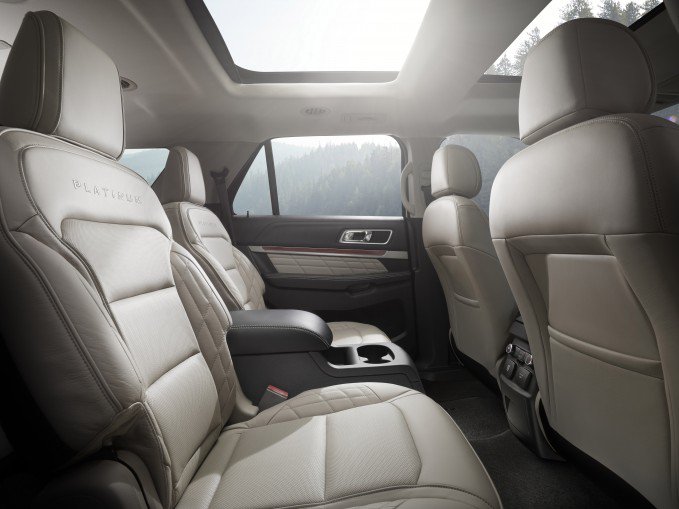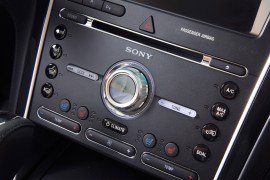If you’re old enough to remember when Reagan was president, you’re probably old enough to remember when the Ford Explorer was the SUV to beat. Today, it languishes in the category that it helped to create — but if you spend a little time with the 2016 Explorer, you might think it’s getting a bad rap that it doesn’t deserve.
Technically, the 2016 model is what the automakers call a “mid-cycle refresh” — updated styling and a few new gee-gaws to freshen its market appeal — but the Explorer’s 2016 re-do is actually far more extensive. The look is new, with squared-off styling that gives it a closer resemblance to bigger Ford SUVs (not to mention the Land Rover Discovery Sport). But there’s big news under the hood, and that’s where we wanted to go first.
Big Engine Upgrades
Back in 2012, Ford introduced the 2.0-liter EcoBoost turbocharged engine to the Explorer as a more fuel-efficient substitute for a traditional V6. We thought the 2.0-liter delivered acceptable (if not stunning) acceleration, but with no all-wheel-drive option and no opportunity in our brief test drive to check real-world fuel economy (always a sore spot for Ford’s EcoBoost four cylinders), we can’t say we were blown away.
For 2016, the 2.0-liter engine gives way to the 2.3-liter EcoBoost. This is the same engine found in the Ford Mustang and Lincoln MKC, but with ECU tuning unique to the Explorer. Power output is 280 HP and 310 lb-ft of torque, up 40 and 40, respectively, from the 2.0-liter EcoBoost, and what a difference it makes. Aside from a brief hesitation off the line as the turbo spools up, the EcoBoost-equipped Explorer now hustles like an SUV with a proper V6 engine.
Also notable is the fact that the 2.3-liter engine can now be had with all-wheel-drive, specifically Ford’s multi-mode system with selections for sand, snow and mud. And it can tow — only 3,000 lbs, mind you, which is 2,000 lbs less than V6-powered Explorers — but that should be enough to get your boat to the lake, provided it’s a very small boat.
SEE ALSO: 2016 Honda Pilot Road Test
With the increase in power comes a slight decrease in EPA-rated fuel economy: 19 mpg city and 28 mpg highway for the front-driver, down 1 mpg in town and holding steady out on the highway. With all-wheel-drive, those figures drop to 18/26. We haven’t had much luck matching EPA figures in the real word with Ford’s EcoBoost engines — turbocharged engines use a lot more fuel when the turbo is doing its thing, and when you’ve got a small-ish engine hauling a heavy vehicle (around 4,500 lbs in the case of the Explorer), the turbo has its work cut out for it. We’ll reserve judgement until we’ve had a longer test drive in the Explorer, but if we had to take an educated guess, we’d predict that 2.3-liter EcoBoost owners will see around 20 mpg, maybe a bit less.
Meanwhile, our favorite Explorer engine returns with no changes: The 365 horsepower twin-turbo EcoBoost V6. Still going strong with 365 HP and 350 lb-ft of torque, this engine reminds us of the days when you could get an Explorer with a V8 engine. The 3.5L EcoBoost comes exclusively with all-wheel-drive, and since the stout V6 has less reliance on its turbochargers for simple keep-up-with traffic driving, we think it’ll come much closer to its EPA fuel economy estimates of 16 mpg city and 22 mpg highway.
SEE ALSO: Ford Builds Five Millionth EcoBoost Engine
Incidentally, this engine was previously the exclusive domain of the Explorer Sport model, which returns this year with its blacked-out grille and unique suspension and steering setup designed to give it a sportier feel (though “sporty” is all relative term in a two-and-a-quarter ton SUV). For 2016, the 3.5-liter EcoBoost engine also sees service in the new top-line Platinum version, which, like the other variants, is tuned for a quieter and more comfortable drive.
All Explorers get slightly softer steering for a more relaxed driving feel, and while we normally abhor such changes — bring on the sport, we say! — we liked the way the retuned Explorer went down the road.
Oh, we almost forgot — there’s one other powerplant in the Explorer lineup, the 3.5-liter (non-turb
ocharged) V6 base engine, with 290 HP and 255 lb-ft and a choice of front- or all-wheel-drive. While it lacks the adrenaline-pumping potential of the EcoBoost V6 and the high-tech bragging rights of the EcoBoost four, we were impressed by its smooth, even power delivery and quiet demeanor. This engine allows the Explorer to tow 5,000 lbs, and its EPA fuel economy estimates of 17 mpg city/24 mpg highway (16/23 with all-wheel-drive) should be easily achievable in day-to-day driving. Much as we like talking about the other engines, this modest motor is arguably the best and most practical choice.
Hauls like an SUV Should
Speaking of practicality, let’s talk about what the Explorer does best: Accommodating people. In most seven-seat SUVs, the third row is a bad joke — a tiny perch sized for small children that is really only useful in a pinch. Not so with the Explorer: It gets a proper third-row seat with a humane amount of leg- and head-room, mounted high enough off the floor so that your knees won’t be vying for position with your nostrils. We can’t think of any other seven-seater that offers such a comfortable third row, though the new 2016 Honda Pilot comes close.
Not only is the Explorer one of the few seven-seat SUVs that can accommodate seven adults, it’s one of the few that can do so and still offer a reasonable amount of cargo space: 21 cubic feet, about as much as a small hatchback, and arranged so as to accommodate not only groceries but suitcases stood on edge.
When not needed, the third-row seats fold down minivan-style into a well in the floor, opening up 43.9 cubic feet of space with a flat (albeit slightly angled) floor. Said folding (and unfolding) is accomplished with well-marked and easy-to-reach pull-straps on lower-spec Explorers, and electrically on higher-end models. Second-row seats double over and flip up against the front seats, providing easy access to the third row as well as a maximum 81.7 cubic feet of cargo space.
High-Tech Interior Stays Much the Same
Drivers familiar with the outgoing Explorer will not find much different behind the wheel; changes in décor are minor, and that’s fine with us, as we like the look of the Explorer’s dash. We’re less fond of Ford’s MyFord Touch infotainment system, which has been the victim of much criticism in the press, most of which is well-deserved. For those unfamiliar, MyFord Touch uses a four-zone touchscreen, along with thumb-buttons on the steering wheel and miniature screens on the dashboard, to control the stereo, climate and navigation systems. Even if you know your way around the system, the small lettering and menu-based selections take too much attention away from the road, and we’d like to see Ford replace this system with something less complicated.
The Explorer has never been shy when it comes to gadgets; carry-over options include adaptive cruise control, blind-spot and lane-departure warning, a self-parking system, and a giant dual-pane moonroof. For 2016, the Explorer ups the techno ante significantly: The self-parking system now backs into perpendicular spots as well, and it can help the driver squeeze out of those super-tight parallel spots it was able to squeeze into.
The Explorer offers the kick-to-open rear liftgate (with the key on your person, waving your leg under the rear bumper opens the trunk); front and rear wide-angle cameras with a self-washing feature; high-amp USB ports to charge tablets and other large devices; airbag-equipped second-row seat belts, which provide better crash protection for children; and a new high-end 500-watt Sony audio system.
Most of these gadgets can be found in the new Platinum model, which supplants the Sport as the top-of-the-line Explorer. Equipped with the 3.5-liter EcoBoost engine and all-wheel-drive, the Explorer Platinum does not come cheap: $53,545 for starters and nearly $58k with all options and accessories. Ford insists there’s a market for such a high-end Explorer, but that boosts the Explorer Platinum past the top-of-the-line Nissan Pathfinder Platinum ($43,995) and Honda Pilot Elite ($47,300) and well into Audi, BMW and Mercedes territory, where buyers consider status as well as (if not more than) content.
The Verdict: 2016 Ford Explorer Review
Comp
ared to the Platinum, the base-model Explorer seem like a bargain: $31,645 with front-wheel-drive, a limited color palette, and standard-fit 18-inch wheels and keyless ignition. But watch those extras: A mid-line Explorer XLT with optional all-wheel-drive, dual-zone climate control, heated leather seats and navigation lists for just over $40,000.
Discuss this story on our Ford Forum







